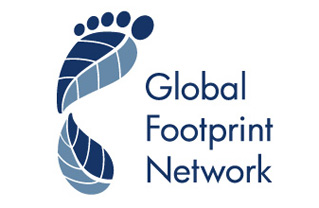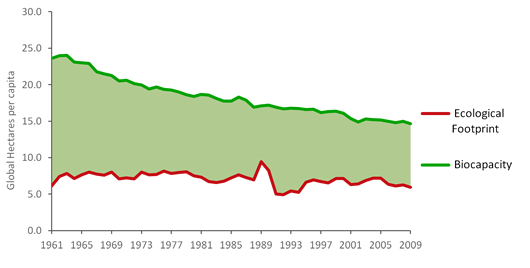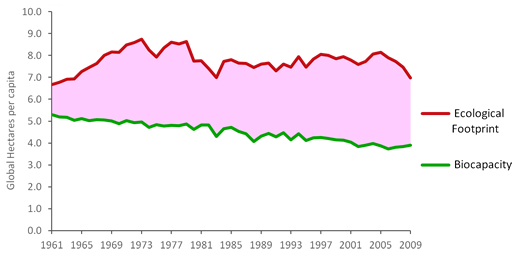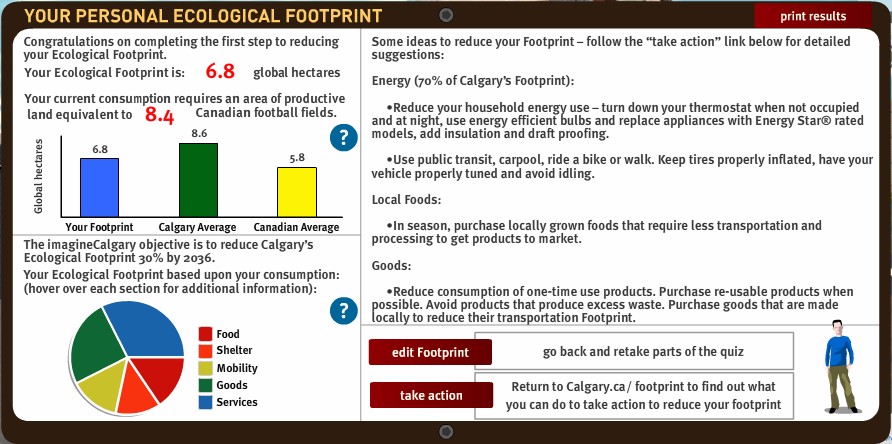Proponents of an accounting tool that measures human impact on nature, the Global Footprint Network is dedicated to making governments and other decision makers use ecological limits in developing policy and implementing programs.
Back in the 1970s economists and researchers talked about limits and in particular pointed to an impending date when we would run out of oil. Of course time has proven them wrong as new technologies have greatly expanded fossil fuel reserves.
But in defining limits these researchers established the principle that humans needed to seriously look at how we could sustain our modern civilization indefinitely. Hence the development of what is becoming an important field of study – footprint science.
We know that our planet is abundantly endowed with resources but we also know that these are finite. As a result through efforts at the United Nations we are assembling 6,000 data points from 232 countries and territories to measure consumption and resource capacity over time. Each nation has a National Footprint Account. The one below is for Canada.
Note that biocapacity even in a resource rich country like mine is declining related to our ecological footprint, the latter being a calculation of our total consumption of resources.
Now look at the National Footprint of the United States.
Note that America’s footprint is exceeding its biocapacity by an increasing margin since the 1960s. And the United States isn’t alone. Despite many countries committing themselves to sustainable development most are failing to measure up to the standard with ecological footprints exceeding biocapacity. This is a recipe for potential disaster. But as they say in any redemptive therapy, awareness is the first step on the way to being able to do something about rejigging our use of the planet we live on.
The Global Footprint Network provides guidance for cities, business and individuals let alone nations to begin to adjust our behaviour to embrace sustainability and measure our efforts to achieve it. For government it gives metrics that can be worked with to assess progress. For individuals it gives us the means to create our own personal footprint calculation.
If you currently reside in the U.S., Canada or Australia right now you can find out the measure of your personal footprint. Just go to the Footprint Calculator, select your location and answer the quiz. If you want to participate in establishing a footprint calculation for your organization then you can email calculators@footprintnetwork.org to get started.
The Canadian footprint is based on calculations developed using data submitted by the City of Calgary. I live in Toronto but took the test (see the results below) and found out that my family’s current footprint is 6.8. That number equals the global hectares of land necessary to sustain the three of us. And it equates to an area of land the size of 8.4 Canadian football fields. If you are not familiar with our brand of football, a Canadian field is approximately 137 meters (150 yards) by 60 meters (65 yards). Multiply that by 8.4 and you have a lot of land to sustain the three of us. And this is after the exercise of downsizing our carbon footprint. We will endeavor to do better.













Since 1961, US population has increased by over 60%. What would the US “Global Footprint” chart look like if its population were reduced to 170-million? What would Canada’s chart look like if its population were 20-million?
No matter how much lipstick you slather on a pig, it’s still a pig. Over the next 20-30 years, only drastic population reduction can balance resources, consumption, environment, and maintain quality of life. If the developed world consumes fewer resources per capita, the undeveloped world will immediately seize them and begin converting them into an even larger population.
Where’s the telling argument for the first world population to rush to the bilges and start bailing? Isn’t it obvious that if the first-world abandons the upper decks to begin serious bailing down in the bilges, the third world will rush to the upper decks and delight in taking its place? So, in effect, the sinking overloaded vessel would have to either provide more buoyancy or sink even faster. Of course there will be those who argue that the solution is to reduce the weight of each passenger, especially the bailers, but the truth is third-worlders would promptly convert the surplus resources made available by restricting the diet of first world bailers into greater numbers of hungry third-worlders, who have almost no capacity to bail.
I’m not saying we must start casting all the breeding non-bailers into the sea, but if their numbers are not somehow restrained, and drastically reduced, it’s just a matter of time before the ship of industrial civilization will surely plunge to the bottom.
If I had a magic LENR energy technology, or John Gault’s secret power machine, that produces electrical power at ten percent the cost of burning coal (say an actual working E-Cat-hot), I wouldn’t make it available to global civilization. I would try to ration its benefits only to nations with restricted immigration and falling populations. I would move to New Zealand and try to deal first with Japan and China. I’m very suspicious of India, but something could probably be worked out so power rates would be related to reproductive rates. (Childless Indian couples get free electricity; one-child couples pay one-cent kWh; two-child couples pay four-cents; three child couples pay twelve-cents; four-child couples pay thirty cents, and so on. If such a power cost scheme would work in India, it might work nearly anywhere.) The magic energy machine could power AI mind meld and virtual reality chambers for the world’s billions and save the environment in the process. The problem with that beautiful vision is it’s only possible with magic that doesn’t actually exist. So for the next 40-50 years we are stuck in the real world, with rationing electronic AI mind meld and robotic nuclear power as the least bad of all possible futures.